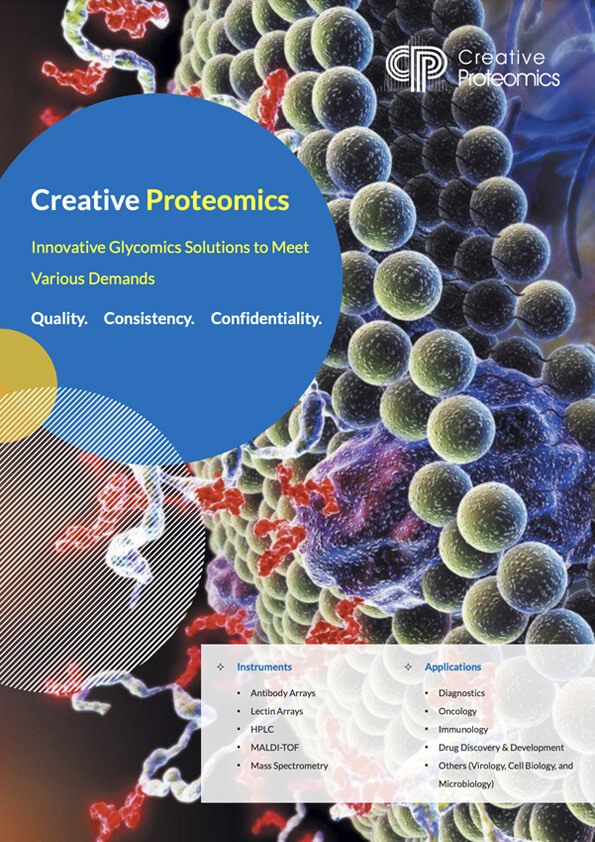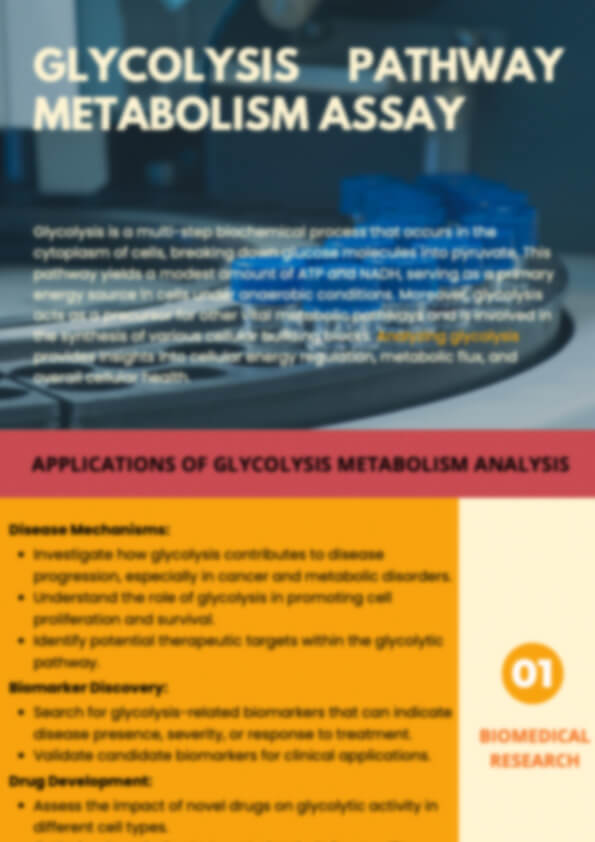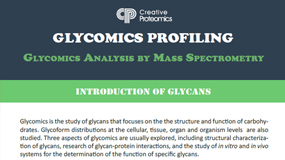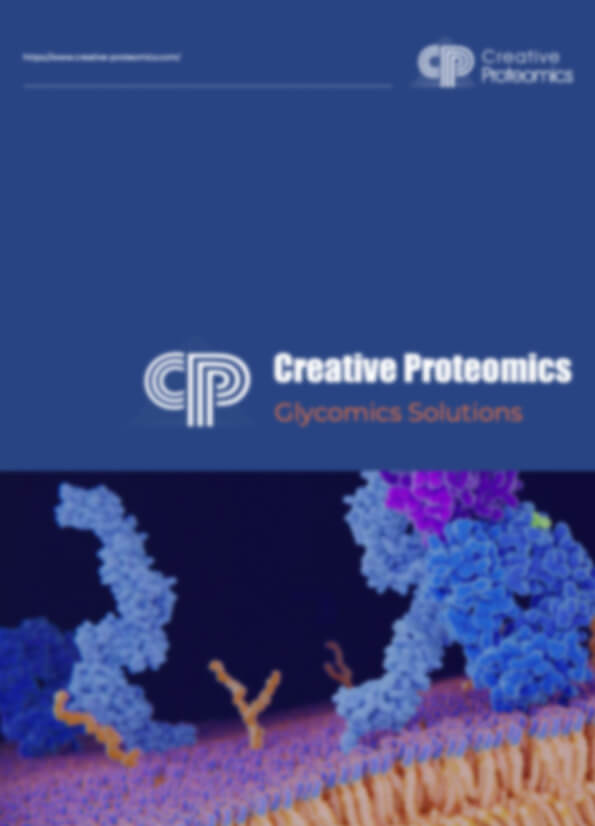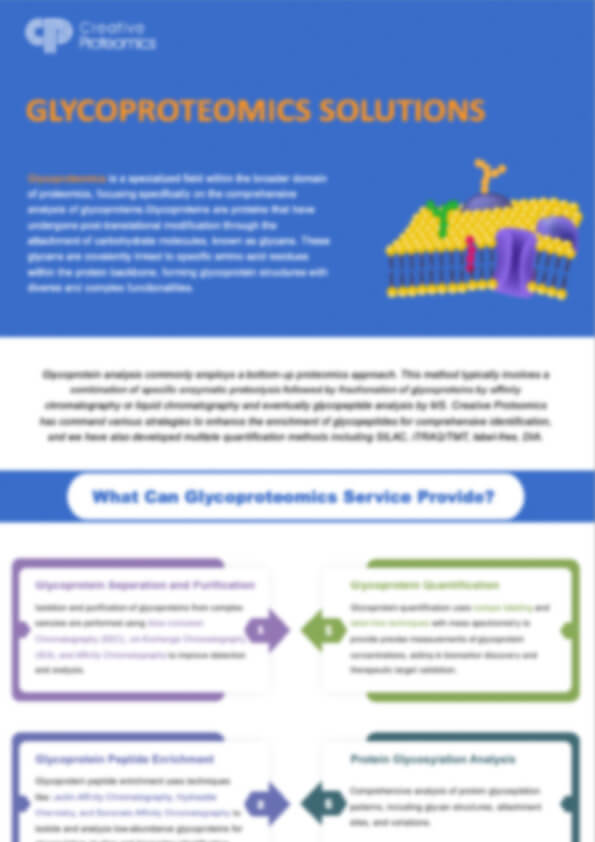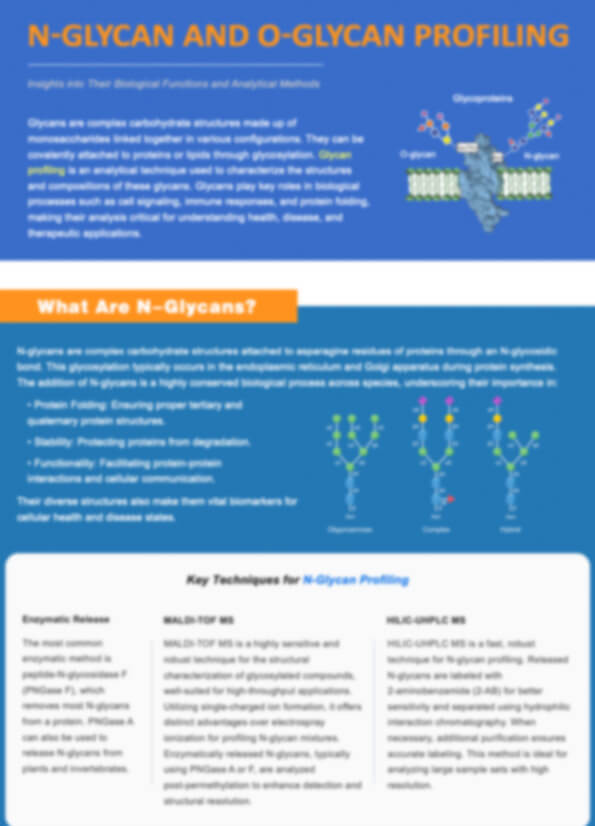Advance Research with Polysaccharide Analysis and Linkage Profiling
Polysaccharides play essential roles in biology and industry, yet their structural complexity poses analytical challenges. Creative Proteomics offers end-to-end polysaccharide analysis by HPLC, SEC-MALS, GC-MS, FTIR, and NMR to accurately characterize molecular weight, monosaccharide composition, and linkage structure. Our solutions support researchers, biotech teams, and pharma clients with publication-ready, reproducible results for R&D and quality control.
Problems We Solve:
- Inconsistent results from single polysaccharide test methods
- Difficulty linking polysaccharide structure to biological activity
- Complex sample purification and characterization needs
- Regulatory and QC requirements for polysaccharide-based products
Our Advantages:
- Advanced HPLC, SEC-MALS, GC-MS, and NMR platforms
- Full workflow: isolation, purification, composition, and structure analysis
- Experienced glycomics team with CRO-level bioinformatics support
- Data deliverables designed for publication and regulatory submission
Submit Your Request Now
×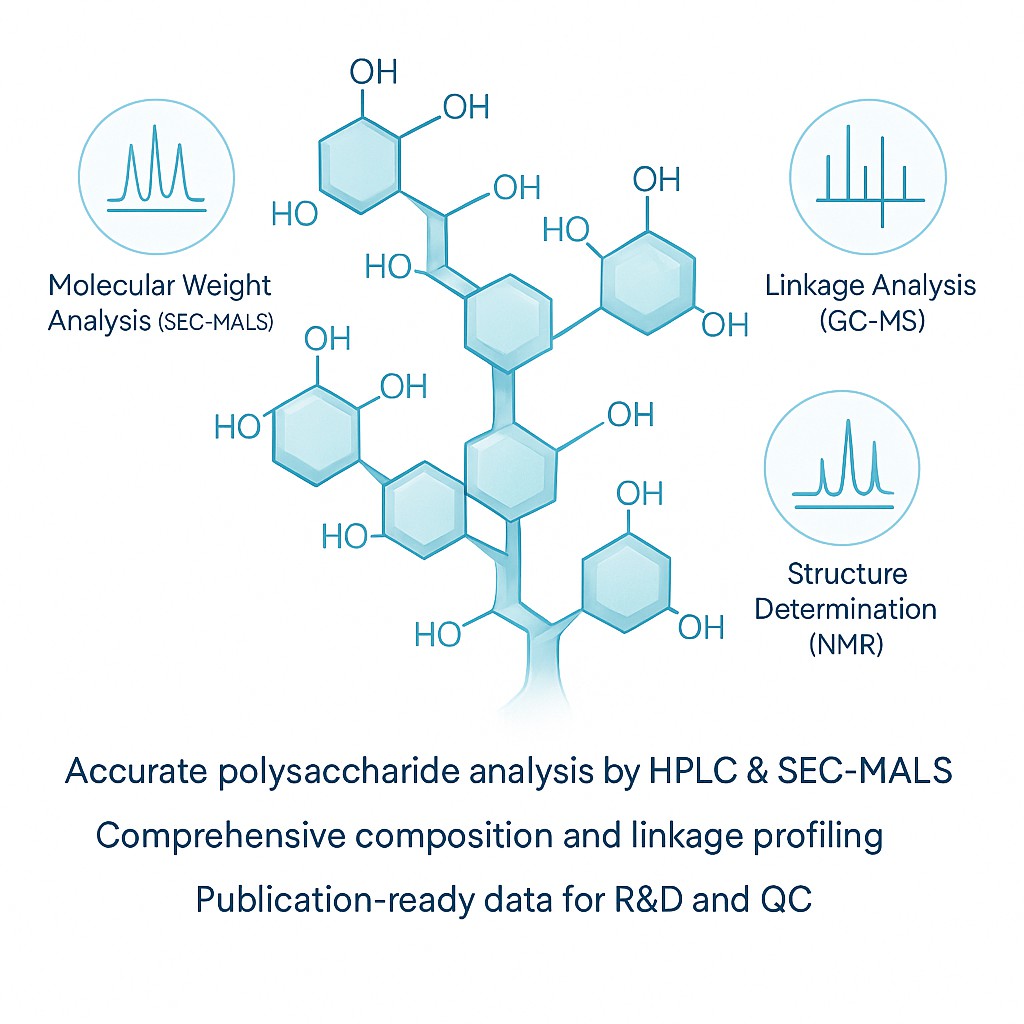
- Introduction
- Technical Approach
- Applications
- Practical Information
- FAQs
What Are Polysaccharides and Why Analyze Them?
Polysaccharides are long carbohydrate polymers composed of repeating monosaccharide units connected by glycosidic linkages. They are widely distributed in plants, animals, microorganisms, and marine organisms, where they serve structural, storage, and regulatory functions. Examples include starch, cellulose, glycogen, and chitosan, each with unique biological and industrial roles.
The complexity of polysaccharide structures—ranging from linear to highly branched chains with diverse monosaccharide compositions—creates both opportunities and challenges. Slight variations in linkage position or molecular weight distribution can significantly influence biological activity, solubility, viscosity, and functional properties.
Analyzing polysaccharides provides critical insights into:
- Structure–activity relationships that link molecular architecture to immunomodulatory, anti-inflammatory, or antioxidant effects.
- Polysaccharide composition analysis for quality control in pharmaceuticals, food, and functional ingredients.
- Non-starch polysaccharide analysis to evaluate dietary fibre and nutritional profiles.
- Polysaccharide structure analysis to support drug discovery, biomaterials development, and glycomics research.
Precise characterization using validated polysaccharide test methods such as HPLC, SEC-MALS, and NMR is essential for advancing both basic research and applied product development.
Our Polysaccharide Analysis Services
Creative Proteomics provides a comprehensive suite of polysaccharide analysis methods to address diverse research and development needs. Our platform integrates chromatography, spectroscopy, and mass spectrometry to deliver reliable structural and functional insights.
Polysaccharide Isolation and Purification
- Removes proteins, pigments, and small-molecule contaminants.
- Uses size-exclusion chromatography, ion exchange chromatography, or membrane-based purification.
- Provides highly pure polysaccharide fractions for downstream analysis.
Polysaccharide Content Determination
- Accurate quantification using phenol–sulfuric acid colorimetric assays.
- Suitable for comparing total polysaccharide content across biological extracts.
- Provides fast, reproducible data for raw material evaluation and product development.
Molecular Weight Determination of Polysaccharide
- HPLC and SEC-MALS polysaccharide analysis for molecular weight and distribution.
- Characterizes average molecular weight, polydispersity, and aggregation state.
- Supports regulatory quality control and structure–activity research.
Polysaccharide Composition Analysis
- Identifies monosaccharide types such as arabinose, galactose, glucose, mannose, and fucose.
- Uses ion chromatography, GC, and HPLC for sensitive quantification.
- Enables differentiation of homopolysaccharides and heteropolysaccharides.
Polysaccharide Linkage Analysis
- Methylation analysis, Smith degradation, and FTIR spectroscopy for glycosidic bond characterization.
- Determines linkage position, configuration, and branching patterns.
- Delivers detailed connectivity maps for polysaccharide structure analysis.
Polysaccharide Structure Analysis
- Advanced 1D/2D NMR, FTIR, LC-MS, and GC-MS platforms.
- Resolves stereochemistry, ring size, substituents, and higher-order structures.
- Supports drug discovery, glycomics, and oligosaccharide and polysaccharide analysis.
Determination of the Absolute Configuration
- Identifies whether sugars are in D- or L-configuration.
- Essential for stereochemical assignment and biological relevance.
Identification of the Anomeric Configuration
- Determines whether glycosidic linkages are α or β anomers.
- Provides critical information for polysaccharide structure–activity studies.
Polysaccharide Sequencing
- Breaks down complex polysaccharides into defined oligosaccharide fragments.
- Establishes linkage order, repeating units, and chain motifs.
- Enables fine-scale polysaccharide structure analysis and functional correlation.
Specialized Polysaccharide Projects
- Expertise in analyzing non-starch polysaccharides, fucoidan, chitosan, glycogen, and glucans.
- Tailored workflows for unique polysaccharide sources and bioactivities.
- Supports custom requests for oligosaccharide and polysaccharide analysis projects.
Analytical Techniques for Polysaccharide Testing
| Category | Service Name | Service Content | Testing Method |
|---|---|---|---|
| Physicochemical | Polysaccharide Purity & Molecular Weight Determination | Detects sample purity, molecular weight, and molecular weight distribution | GPC-RI-MALS, HPGPC |
| Polysaccharide Chemical Composition Analysis | Measures total sugar, protein, uronic acid, and moisture content | Spectrophotometry, specific gravity methods | |
| Monosaccharide Composition Analysis | Identifies monosaccharide components and their relative contents | Ion Chromatography (ICS) | |
| Structural | UV-Vis Spectroscopy | Detects nucleic acid and protein contamination | UV-visible spectrophotometry |
| Infrared (IR) Spectroscopy | Identifies sugar ring configurations and anomeric carbon information | FT-IR | |
| Bonding Structure Analysis (Methylation) | Determines glycosidic bond positions, connectivity, and molar ratios | GC-MS (Methylation Analysis) | |
| 1D NMR | Provides baseline structural insights (¹H-NMR, ¹³C-NMR, DEPT) | NMR Spectrometer | |
| 2D NMR | Advanced connectivity mapping (COSY, HSQC, HMBC, NOESY/ROESY, TOCSY) | NMR Spectrometer | |
| Advanced Structure Analysis | Examines stability, microstructure, chain conformation, and crystallinity | Congo Red, SEM, AFM, XRD, Circular Dichroism, Modelling | |
| Other | Polysaccharide Isolation & Purification | Removes proteins, pigments, salts, and small-molecule contaminants | Size-exclusion / Ion-exchange Chromatography |
Workflow: From Sample to Structural Insights
Our polysaccharide analysis services follow a stepwise workflow that ensures accuracy, reproducibility, and clear reporting for every project.
1. Sample Preparation and Extraction
- Polysaccharides are isolated from plant, microbial, or animal sources.
- Extraction methods include hot water, enzyme-assisted, or solvent extraction depending on the sample type.
- Contaminants such as lipids, proteins, and pigments are removed using optimized procedures.
2. Polysaccharide Isolation and Purification
- Fractions are purified using size-exclusion chromatography, ion exchange chromatography, or membrane separation.
- This step yields highly pure polysaccharide samples for downstream characterization.
3. Polysaccharide Test Methods
- Polysaccharide analysis by HPLC and SEC-MALS provides molecular weight distribution.
- Polysaccharide composition analysis identifies monosaccharide ratios.
- Polysaccharide linkage analysis determines glycosidic connectivity and branching.
- Polysaccharide structure analysis uses NMR, FTIR, GC-MS, and LC-MS to define stereochemistry and substituents.
4. Advanced Structural Assignments
- Determination of the absolute configuration reveals D- or L-stereochemistry.
- Identification of the anomeric configuration establishes α- or β-linkage orientation.
- Polysaccharide sequencing defines repeating units, linkage order, and higher-order motifs.
5. Data Integration and Bioinformatics
- Cross-platform results are combined for robust interpretation.
- Findings are benchmarked against glycomics databases and reference standards.
- Custom analyses support structure–activity studies and quality control.
6. Deliverables
- Clients receive a complete reporting package:
- Quantitative data tables (molecular weight, composition, linkages).
- Annotated spectra and chromatograms.
- Structural maps and connectivity diagrams.
- Expert commentary linking data to functional or regulatory implications.
Analytical Platforms
At Creative Proteomics, we integrate state-of-the-art analytical platforms to provide robust and reproducible polysaccharide analysis. Each method is selected based on sample type, research goals, and regulatory requirements.
Chromatography Platforms
- HPLC polysaccharide analysis for molecular weight distribution and composition profiling.
- SEC-MALS (Size Exclusion Chromatography–Multi-Angle Light Scattering) for absolute molecular weight and aggregation state.
- HPGPC for high-resolution separation and relative molecular weight estimation.
Spectroscopy & Structural Tools
- FT-IR for sugar ring configuration and glycosidic bond characterization.
- UV-Vis spectroscopy for contamination detection (nucleic acids, proteins).
- NMR (1D & 2D) for stereochemistry, linkage sequence, and structural conformation.
Mass Spectrometry & Advanced Imaging
- GC-MS and LC-MS for detailed monosaccharide and linkage analysis.
- Methylation analysis coupled with MS for glycosidic bond mapping.
- SEM, AFM, and X-ray diffraction for visualization of microstructure, surface morphology, and crystallinity.
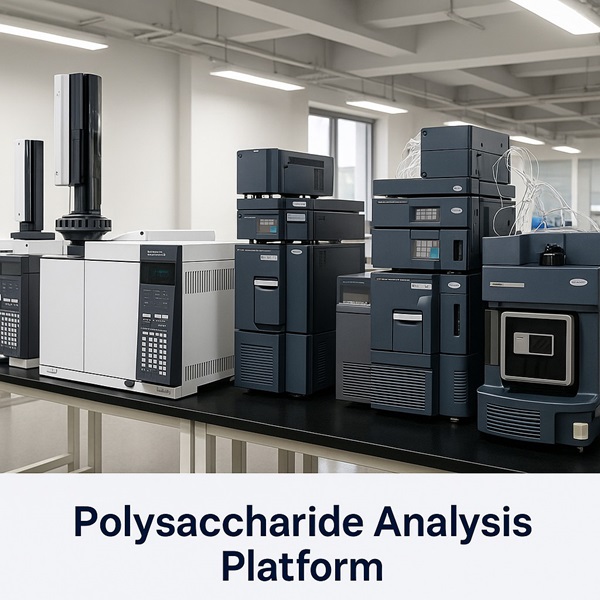
These platforms ensure that Creative Proteomics provides end-to-end polysaccharide analysis services, covering everything from composition analysis to polysaccharide structure analysis with industry-grade precision.
Applications of Polysaccharide Analysis
Polysaccharides have wide-ranging roles in healthcare, nutrition, and biotechnology. Understanding their composition, linkage, and structure provides critical insights for both fundamental research and product development.
Pharmaceutical and Biotech Research
- Supports drug discovery and vaccine adjuvant development by linking structural motifs to biological activity.
- Enables polysaccharide structure analysis for immunomodulatory and anti-inflammatory candidates.
- Provides data for regulatory filings and quality control of therapeutic polysaccharides.
Recommended reading: Polysaccharides in Immunity and Therapeutics.
Food and Nutrition
- Non-starch polysaccharide analysis helps assess dietary fibre content and nutritional value.
- Supports formulation of functional foods and nutraceuticals by characterizing solubility, viscosity, and bioactivity.
- Ensures consistency and safety in food additives derived from natural polysaccharides.
Agricultural and Environmental Science
- Characterizes polysaccharides from plants and soil microbes to study plant–microbe interactions.
- Evaluates polysaccharide-based biostimulants and biofertilizers for sustainable agriculture.
- Provides insight into microbial extracellular polysaccharides and their role in stress tolerance.
Glycomics and Basic Research
- Facilitates oligosaccharide and polysaccharide analysis in glycomics projects.
- Generates datasets for structure–activity relationship (SAR) studies, supporting academic publications.
- Enables precise polysaccharide composition analysis across species, strains, or conditions.
Related resource: The Method and Process of Polysaccharides Analysis.
Why Choose Creative Proteomics
Selecting the right partner for polysaccharide research is critical for achieving reliable, publication-ready results. Creative Proteomics combines advanced technology with expert support to deliver end-to-end polysaccharide analysis services.
Our Key Advantages
- Comprehensive Coverage – From polysaccharide isolation and purification to sequencing, linkage analysis, and structure determination, we provide complete workflows.
- Multi-Platform Validation – Results are cross-verified using HPLC, SEC-MALS, NMR, FT-IR, GC-MS, and advanced imaging, ensuring accuracy and reproducibility.
- Low Sample Requirement – Typically only 5–10 mg of polysaccharide powder is needed for most projects.
- Flexible Solutions – Tailored services for academic research, biotech innovation, CRO collaborations, and pharma development.
- Regulatory-Ready Data – Deliverables formatted for quality control, product validation, and regulatory submissions.
- Expert Support – A dedicated glycomics team with decades of combined experience in carbohydrate analysis.
Trusted by Global Researchers
Our track record includes successful projects with universities, research institutes, and biotech companies worldwide. Clients rely on Creative Proteomics for accurate polysaccharide composition analysis, non-starch polysaccharide testing, and advanced structural characterization to support both discovery and development pipelines.
With Creative Proteomics, you gain a reliable partner equipped to translate complex polysaccharide data into actionable insights for research and product innovation.
Sample Requirements
Accurate polysaccharide analysis depends on the quality of submitted samples. Please prepare your samples following the guidelines below to ensure reliable and reproducible results.
| Sample Type | Recommended Quantity | Preparation Guidelines |
|---|---|---|
| Dry polysaccharide powder / lyophilized material | 5–10 mg per sample | Store at –20°C or –80°C. Avoid moisture. Ensure uniform mixing before aliquoting. |
| Plant tissues (leaves, stems, roots, seeds) | 100–200 mg fresh or dried | Remove surface contaminants. Flash-freeze in liquid nitrogen, store at –80°C, ship on dry ice. |
| Microbial samples (cell pellets, cultures) | ≥50 μL pellet or 2–5 mL culture | Wash pellets with PBS 2–3 times. Remove medium proteins. Flash-freeze, ship on dry ice. |
| Animal tissues (liver, spleen, cartilage, etc.) | 100–200 mg | Remove blood/debris with PBS. Flash-freeze in liquid nitrogen, store at –80°C. |
| Fluids (serum, plasma, culture supernatant) | 100–200 μL | Centrifuge to remove debris. Aliquot, flash-freeze, and ship with sufficient dry ice. |
| Special polysaccharides (fucoidan, glycogen, chitosan) | ≥5 mg | Provide source details and solvent compatibility. If dissolved, indicate buffer composition. |
| Replicates | ≥3 biological replicates | Clearly label as Sample-1, Sample-2, etc. to ensure statistical validity. |
General Notes
- Avoid repeated freeze–thaw cycles.
- Label all tubes clearly with sample ID, source, and preparation method.
- For solutions, provide buffer information (e.g., salts, solvents, additives).
- If special treatments were applied (e.g., enzyme digestion, chemical modification), document details in the submission form.
FAQs
What is the difference between polysaccharide analysis and polysaccharide composition analysis?
Polysaccharide analysis is a broader term covering molecular weight, linkage, structure, and function, while polysaccharide composition analysis specifically determines which monosaccharides are present and in what ratio after hydrolysis into monomers.
Can you perform polysaccharide analysis by HPLC?
Yes, we offer polysaccharide analysis by HPLC for both molecular weight profiling (e.g. size-exclusion HPLC) and monosaccharide separation after hydrolysis, often paired with refractive index or pulsed‐amperometric detection.
What sample amount is required for polysaccharide linkage and structure analysis?
For linkage analysis (methylation / GC-MS) we typically request several milligrams of purified polysaccharide; for NMR structural elucidation, sample purity is more critical than large quantity.
Do you analyze non-starch polysaccharides?
Yes, our service supports non-starch polysaccharide analysis (e.g. hemicellulose, pectin, gums) using the same platform of HPLC, GC-MS, NMR, and linkage profiling adapted to acidic or neutral polysaccharides.
What is polysaccharide linkage analysis?
Polysaccharide linkage analysis refers to determination of how monosaccharide units are joined (e.g. 1→4, 1→3, branching points), using methylation, periodate oxidation, and GC-MS or NMR to elucidate glycosidic connections.
Can you determine absolute and anomeric configuration of sugars?
Yes, we offer determination of absolute configuration (D vs L) and identification of anomeric configuration (α vs β) as part of our advanced structural services.
What does polysaccharide sequencing entail?
Polysaccharide sequencing breaks the polymer into defined oligosaccharide fragments and reconstructs linkage order, repeating motifs, and fine structural arrangement using tandem MS, HPLC, or NMR methods.
What quality controls do you use to ensure reliable results?
We cross-validate results across multiple platforms (HPLC, SEC-MALS, NMR, MS), include calibration standards, run blanks, and evaluate reproducibility and consistency of technical replicates.
What deliverables will I receive from the analysis?
You will receive a full technical report with chromatograms, spectra, linkage maps, monosaccharide tables, structural interpretations, and guidance for further research or development.
How does polysaccharide test method selection impact results?
The choice of method (HPLC, GC, NMR, etc.) influences sensitivity, resolution, and structural depth. For example, HPLC is excellent for quantification and profiling, but only linkage or NMR methods can resolve branching or stereochemistry.
Learn about other Q&A.
Our Glycomics Review

- Modulation of the Endomembrane System by the Anticancer Natural Product Superstolide/ZJ-101. International Journal of Molecular Sciences.
- Identification of the O-Glycan Epitope Targeted by the Anti-Human Carcinoma Monoclonal Antibody (mAb) NEO-201. Cancer.
- Alternative glycosylation controls endoplasmic reticulum dynamics and tubular extension in mammalian cells. Science Advances.
- Conformational differences between functional human immunodeficiency virus envelope glycoprotein trimers and stabilized soluble trimers. Journal of Virology.
References
- Xu S, Xu X, Wu R. Deciphering the Properties and Functions of Glycoproteins Using Quantitative Proteomics. Journal of Proteome Research. 2023 Jun 2;22(6):1571-1588.
- Dalpathado DS, Desaire H. Glycopeptide analysis by mass spectrometry. Analyst. 2008 Jun;133(6):731-8.
- Fang P, Ji Y, Silbern I, et al. A streamlined pipeline for multiplexed quantitative site-specific N-glycoproteomics. Nature Communications. 2020 Oct 19;11(1):5268.



